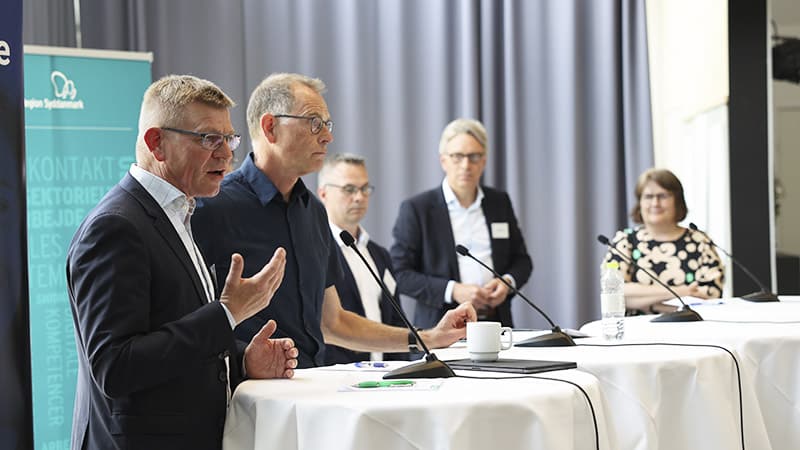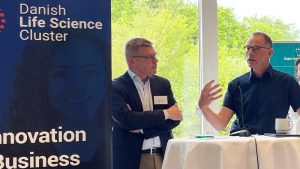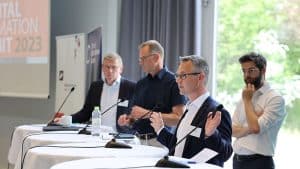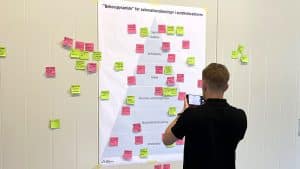More automation in the healthcare sector – here are the barriers and solutions

There is a huge potential for letting automation solutions help a heavily strained healthcare workforce. But the development of solutions does not come by itself – there are too many barriers. So what does it take? Here are suggestions for solutions from the panel at the Hospital Automation Summit 2023.
It’s hard to get your arms down in mere excitement: Robot and automation solutions represent huge potential as labor-saving and staff-relieving technology in the healthcare sector.
So why haven’t we come further – what are the barriers and how do we solve them across hospitals, municipalities, and companies?
This was the theme at the Hospital Automation Summit 2023, which was held in Odense on the 24th of May with 150 participants.
THE BARRIERS for hospitals and companies
In the presentation ‘Barriers for robots in the health sector’, Birgitte Østergaard Sørensen, business manager at the Technological Institute, and Louise Halgaard Gotfredsen, chief consultant at Southern Danish Health Innovation gave their suggestions on barriers for companies in particular, which must be resolved in order for automation solutions to benefit the health sector:
- Hardly transparent sales entry at the hospitals
- A long time horizon in the tender process requires capital
- Complex integration with hospital IT
- Requirements for evidence
- Customized solutions are bad business – they cannot be sold elsewhere.
- Local solutions are difficult to scale
- Product characteristics do not match user needs (healthcare personnel)
- People and organization
Read more about barriers in this report from the Technological Institute.
THE SOLUTIONS from region, hospital, and company
How do we ensure that the healthcare sector benefits from the companies’ innovative solutions to solve the major challenges, and which barriers must we remove together?
The panel at the Hospital Automation Summit 2023 gave their take:

Photo: Syddansk Sundhedsinnovation
Anne-Lise Høg Lejre, head of division, Technological Institute:
– We are in the middle of a huge digital transition that we cannot do without. It is therefore important that we support the development – both for suppliers and for the sake of the public – because this transition cannot support itself on commercial terms.

Bjarne Dahler-Eriksen, medical director, OUH Odense University Hospital – Svendborg Hospital:
– There has been a huge development in the employee culture. Years ago, many were worried about having to work with robots, and today employees themselves are demanding automation solutions.
We must seize this goodwill and become better at adopting the many solutions that we in the public sector ourselves help to develop in various projects.
Erik Jylling, health policy director, Danish Regions:
– One of the challenges is that we work with very short and narrow budget horizons, and at the same time we think of investments that must create value and results in 5, 10, or even more years in the future. Furthermore, you will often find the value of a given investment in a different organization or sector than where it was located. So we need to think in wholes and not in organizational silos.

Photo: Syddansk Sundhedsinnovation
Palle Veje, Business Development, Logistic, OMRON Group:
– The public sector must be clear about their needs. Bispebjerg Hospital alone has recently made a list of its 100 most urgent needs. I wonder if other hospitals have some of the same needs? Why don’t more hospitals or regions join together, so that the companies can see a greater potential of buyers?
Peder Søgaard-Pedersen, director, DI – Danish Industry Life Science:
– There is a need to identify the very specific needs so that companies know where to bid. And then we have to move from thinking about customer-to-supplier relationships and instead think in terms of partnerships.
Per Juul Nielsen, CEO, UVD Robots:
– As a supplier, we often run our heads against the wall due to the organization. There can be thick walls between departments and staff groups. Therefore, I believe that innovation can benefit if we dare to re-evaluate processes, workflows, protocols, and professional boundaries.

Pyramid of needs for automation solutions in the healthcare sector. During the event, the participants had the opportunity to give their suggestions on barriers and proposed solutions in a “pyramid of needs”.
The next step for automation in the healthcare sector
Robotic technology and automation solutions have great potential for future-proofing the Danish healthcare system. But the barriers must be resolved so that the technology frees up staff resources and raises the quality of specific treatments and creates a better working environment for healthcare personnel. Region Southern Denmark has published the analysis “The Southern Danish ecosystem for robotics in the health sector”, which focuses on the strength of the Southern Danish ecosystem for robotics and development points.
Read more: Southern Denmark – A unique ecosystem for robotic technology in the healthcare sector
Hospital Automation Summit 2023 was organized by Odense Robotics, Technological Institute, Center for Clinical Robotics, Syddansk Sundhedsinnovation, and Danish Life Science Cluster.
